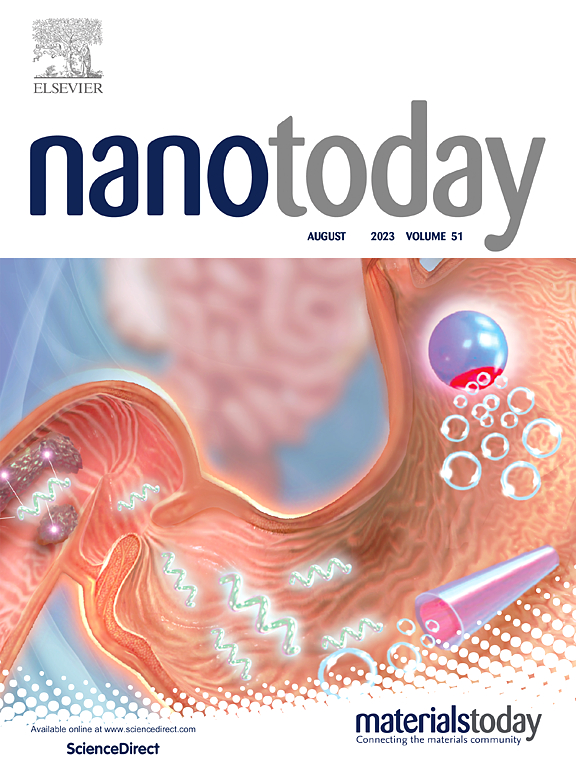纳米凝胶约束的超活性LOx-CPO用于tme反应酶-基因治疗
IF 10.9
1区 材料科学
Q1 CHEMISTRY, MULTIDISCIPLINARY
引用次数: 0
摘要
肿瘤细胞,由于依赖有氧糖酵解,促进肿瘤微环境(TME),其特征是乳酸积累和氧化还原失衡。针对TME的关键代谢底物乳酸,提出了一种基因治疗与酶动力治疗(EDT)相结合的新策略。该策略利用级联氧化酶-过氧化物酶系统,诱导肿瘤DNA损伤,同时抑制修复机制。通过模拟多酶复合物的构建,构建了一个高活性、有序的氧化酶-过氧化物酶和基因平台(ASO-miR21/DLC-NGs)。该平台基于葡聚糖限制乳酸氧化酶(LOx)和氯过氧化物酶(CPO)对,然后是小分子单体诱导的扩散控制自终止聚合,用于高效装载反义寡核苷酸靶向microRNA-21 (ASO-miR21)。通过精确调节尺寸(纳米尺度到微尺度)和交联密度,该方法克服了传统多酶体系稳定性差和底物扩散效率低的局限性。DNA损伤和抗修复的协同作用是通过催化调节活性氧(ROS),逆转氧化还原平衡,下调miR21表达,抑制肿瘤细胞增殖来实现的。异常肿瘤微环境代谢底物的催化转化研究以及代谢调控下的多通路设计可以为专业或跨学科研究多通路肿瘤治疗提供重要见解。本文章由计算机程序翻译,如有差异,请以英文原文为准。
Nanogels confined superactive LOx-CPO for TME-responsive enzyme-gene therapy
Tumor cells, due to their reliance on aerobic glycolysis, contribute to the tumor microenvironment (TME), which is characterized by lactate accumulation and redox imbalances. Targeting lactate, a key metabolic substrate in the TME, a novel strategy combining gene therapy with enzyme dynamic therapy (EDT) has been proposed. This strategy utilizes a cascade oxidase-peroxidase system, which induces tumor DNA damage while simultaneously inhibiting repair mechanisms. By mimicking the construction of multienzyme complexes, a highly active and well-ordered oxidase-peroxidase and gene platform (ASO-miR21/DLC-NGs) has been developed. The platform is based on dextran-confined lactate oxidase (LOx) and chloroperoxidase (CPO) pairs, followed by small molecule monomer-induced diffusion-controlled self-terminating polymerization for efficient loading of Antisense Oligonucleotide targeting microRNA-21 (ASO-miR21). By precisely regulating the dimensions (nanoscale to microscale) and crosslinking density, this approach overcomes the limitations of traditional multi-enzyme systems, such as poor stability and inefficient substrate diffusion. The synergistic effects of DNA damage and anti-repair are achieved by catalytically regulating reactive oxygen species (ROS), which reverses the redox balance and downregulates miR21 expression, inhibiting tumor cell proliferation. The catalytic transformation research of metabolic substrates of abnormal tumor microenvironment and the multi-pathway design with the metabolic regulation can provide important insights for specialized or interdisciplinary researchers on the multipathway cancer therapy.
求助全文
通过发布文献求助,成功后即可免费获取论文全文。
去求助
来源期刊

Nano Today
工程技术-材料科学:综合
CiteScore
21.50
自引率
3.40%
发文量
305
审稿时长
40 days
期刊介绍:
Nano Today is a journal dedicated to publishing influential and innovative work in the field of nanoscience and technology. It covers a wide range of subject areas including biomaterials, materials chemistry, materials science, chemistry, bioengineering, biochemistry, genetics and molecular biology, engineering, and nanotechnology. The journal considers articles that inform readers about the latest research, breakthroughs, and topical issues in these fields. It provides comprehensive coverage through a mixture of peer-reviewed articles, research news, and information on key developments. Nano Today is abstracted and indexed in Science Citation Index, Ei Compendex, Embase, Scopus, and INSPEC.
 求助内容:
求助内容: 应助结果提醒方式:
应助结果提醒方式:


